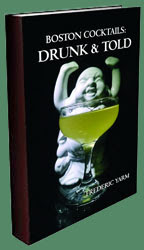Learning history has been a very useful way to relate to guests. Indeed, cocktail knowledge is rather important to some guests as is being able to explain the tapestry of what American whiskey is. However, one of the best ways to relate to guests regardless of what they drink or even if they drink is learning the history of the bar’s space. That space can be the building, the neighborhood, and events going on around it.
In terms of building, one of my previous bars, Russell House Tavern in Harvard Square in Cambridge, MA, relishes the fact that the building’s first occupant in the mid 1800s was furniture dealer Thomas Russell and it helped to tie Harvard Square as a center of business. However, with older guests, it was important to know that the spot was the Wursthaus from 1917 until 1996. Some would regale tales about the quality German beer brands that they served there when America was awash in flavorless macro-beer lagers. And I remember one couple who related that they were too poor as Harvard students to eat at the Wursthaus, but now that they were older and more successful, they could eat in the same space. My next bar, Loyal Nine in East Cambridge has a less regal history in terms of building location, but one that still is important nevertheless. The previous tenants were a successive pair of liquor stores, and neighborhood guests love telling stories about their decline into a near-empty shelved questionable establishment. One of my favorite comments about the space was from an old co-worker who commented, “I used to buy beer underage there,” followed by his girlfriend’s reply of “Yes, a lot of driving around town is a tour of where Adam bought beer underage.”

Loyal Nine’s neighborhood does have a lot of cultural history though being at the intersection of Italian and Portuguese neighborhoods. Both have their respective festivals to learn about with the Italian ones being on the north side of Cambridge Street and the Portuguese ones being on the south side. While the Portuguese ones include parades with marching bands and church bell peels, the Italian festival every summer is a weekend long extravaganza that includes rides, carnie game booths, and food. Most of all, they have bands. One year, they had a few once-famous bands like the Spinners but they also had the current incarnation of the Village People. The Village People playing the neighborhood party was a big conversation piece, so I began to study up on Village People history including which were the original members that were still active, what years the hits were, and what the scandal with the U.S. Navy commercial was all about. That Saturday night, we made the drink of the day a four rum Old Fashioned called In the Navy. Many of our guests that night had either gone to the festival beforehand or were planning to catch the band afterwards, and the others at least knew about the goings on especially since Cambridge Street was blocked off starting a street away. The drink of the day gave a great talking piece to relate ideas about the neighborhood and interesting moments in music during the 1970s. That drink turned out to be the most successful drink of the day, and the recipe is as follows:
In the NavyThe drink could be tied back to that neck of the woods being a major center of rum production before Prohibition, to the history of the song it was named after, or just as a hearty libation to be enjoyed. Bartender’s choice. Or perhaps, it is better said the bartender’s job to read the guest’s choice of what they want to hear about and connect to.
• 1/2 oz Navy Strength Rum (we used Smith & Cross)
• 1/2 oz Local Amber Rum (here, Privateer Amber)
• 1/2 oz Local Amber Rum (here, Old Ipswich Tavern Style)
• 1/2 oz Old Monk Rum (or other dark rum)
• 3/4 oz Demerara Syrup (1:1)
• 1 heavy barspoon St. Elizabeth Allspice Dram
• 2 dash Angostura Bitters
Build in a rocks glass, add ice, stir to mix and chill, and garnish with lemon and lime twists.

 The 2017 collection of 855 drink recipes, bartender tributes, and essays on hospitality from CocktailVirgin's Frederic Yarm. Available at
The 2017 collection of 855 drink recipes, bartender tributes, and essays on hospitality from CocktailVirgin's Frederic Yarm. Available at  The 2012 collection of 505 drink recipes, techniques, and Boston bar recommendations from Frederic Yarm. Available at
The 2012 collection of 505 drink recipes, techniques, and Boston bar recommendations from Frederic Yarm. Available at 




No comments:
Post a Comment